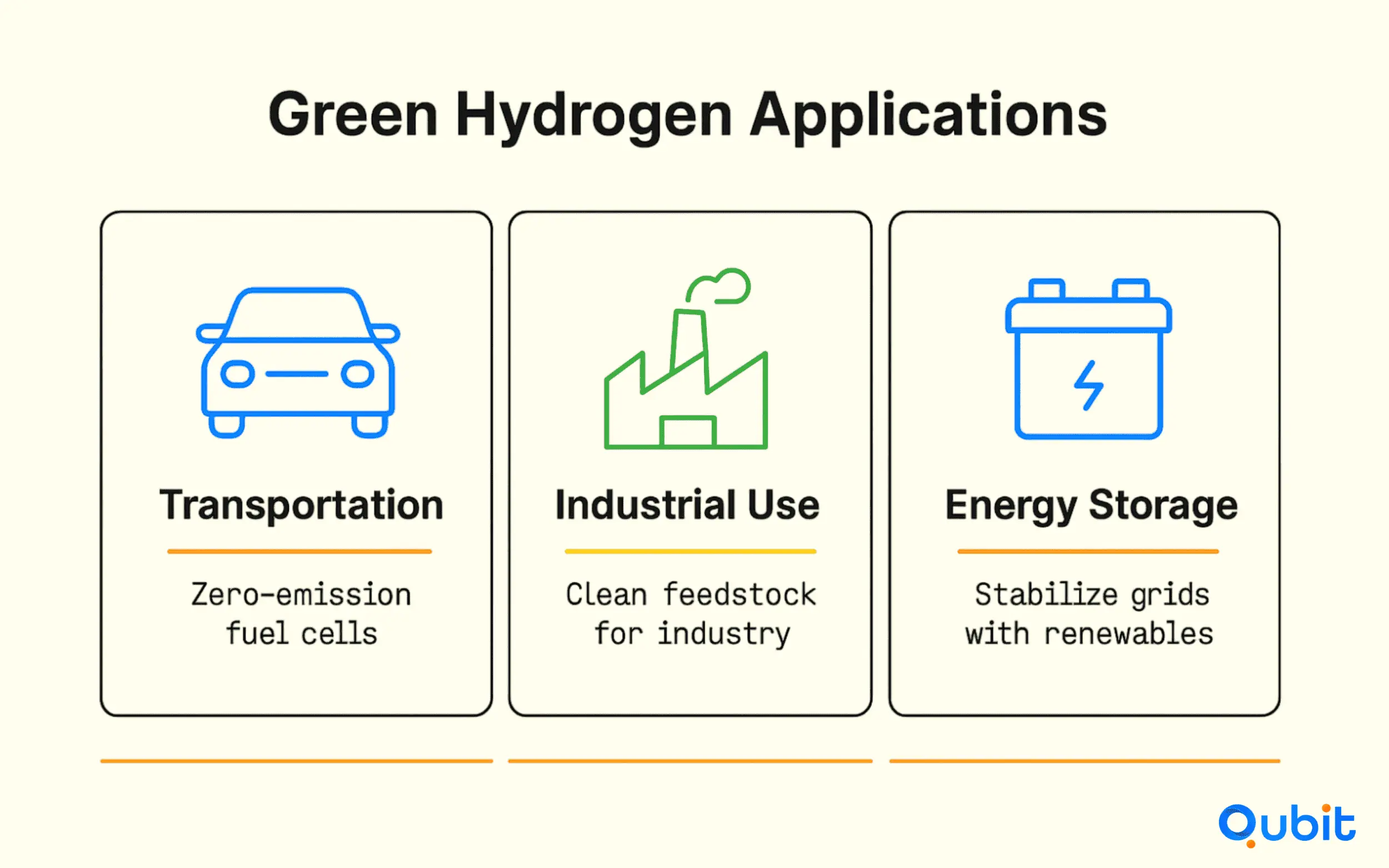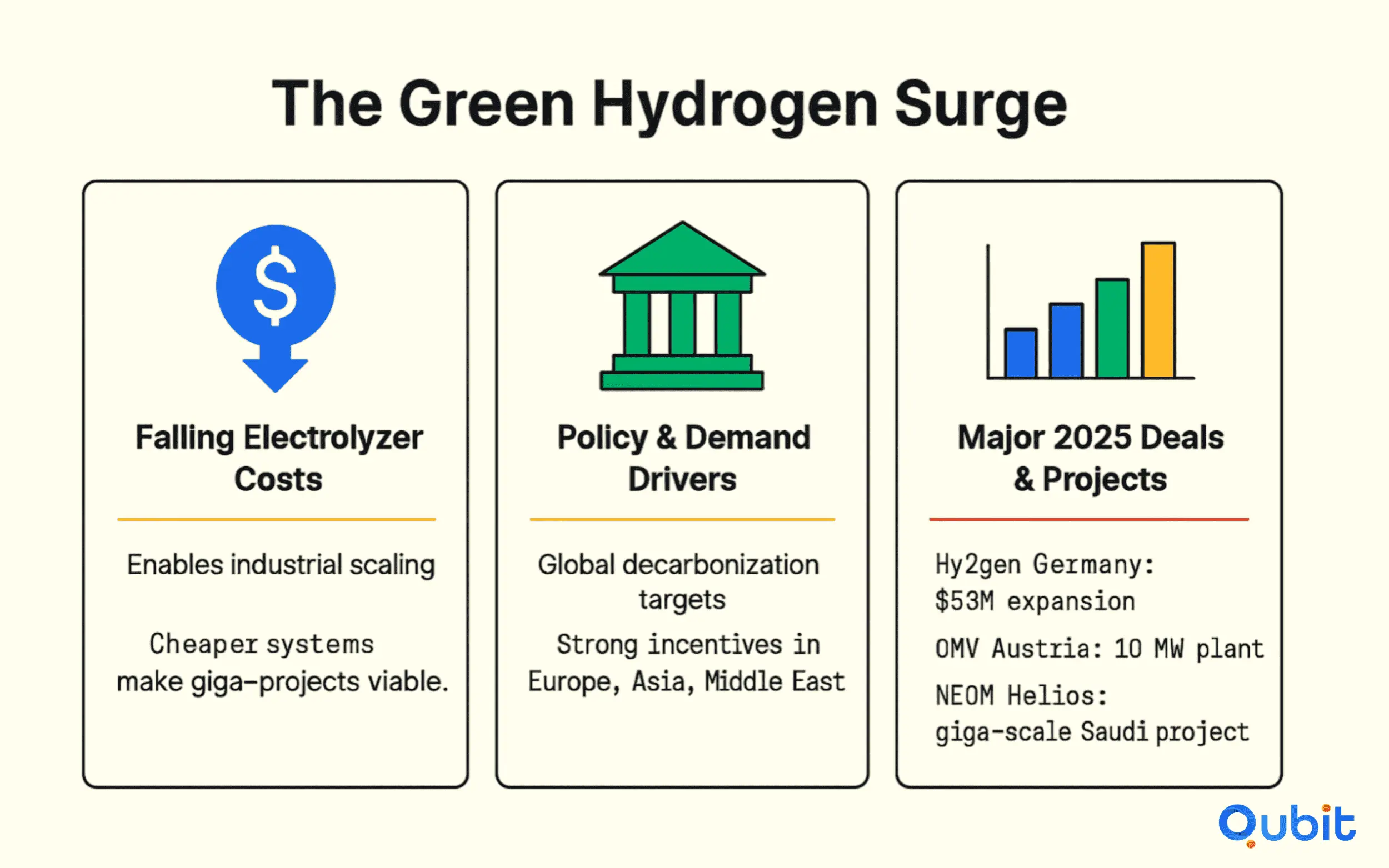The global green hydrogen market size was calculated at USD 8.72 billion in 2024 and is expected to reach around USD 188.12 billion by 2034. This milestone highlights hydrogen's growing role as a pivotal energy carrier in the transition to cleaner energy solutions. As industries and governments worldwide explore sustainable alternatives, hydrogen emerges as a versatile option for decarbonizing sectors like transportation, manufacturing, and power generation.
This article delves into the rise of green hydrogen, examining its applications in Power-to-X technologies, the influence of key policies, and the investment opportunities shaping its future.
For those interested in broader funding approaches within the cleantech sector, exploring cleantech fundraising strategies can provide valuable insights into aligning financial support with green hydrogen initiatives.
Hydrogen Fundamentals & Learning
Green hydrogen is reshaping the energy landscape, offering a sustainable alternative to fossil fuels. At its core, green hydrogen is produced through renewable-powered electrolysis, a process that splits water into hydrogen and oxygen using electricity from sources like wind or solar. This method eliminates carbon emissions, making it a key player in the transition to cleaner energy systems.
Understanding Green Hydrogen Production
The production of green hydrogen relies on electrolysis, which uses renewable energy to separate water molecules. Unlike traditional hydrogen production methods that depend on natural gas and emit significant CO2, green hydrogen is entirely carbon-free. This distinction positions it as a critical solution for industries aiming to reduce their environmental footprint.
Environmental Benefits
Green hydrogen offers unparalleled environmental advantages. By replacing fossil fuels in transportation and industrial applications, it significantly reduces greenhouse gas emissions. Additionally, its production process aligns with global sustainability goals, supporting efforts to combat climate change.

The versatility of green hydrogen extends across multiple sectors:
Transportation: Fuel cell technology powers vehicles with zero emissions, offering a cleaner alternative to conventional fuels.
Industrial Use: Green hydrogen serves as a feedstock for chemical production and metal refining, reducing reliance on carbon-intensive processes.
Energy Storage: It can store excess renewable energy, ensuring grid stability and reliability during peak demand periods.
The Green Hydrogen Surge

Green hydrogen, produced using renewable electricity, has moved from pilot projects to industrial-scale deployment. Falling electrolyzer costs, robust policy support, and ambitious decarbonization targets have fueled a wave of new projects and funding rounds in 2025. Major economies in Europe, Asia, and the Middle East are racing to build large-scale green hydrogen plants, with giga-scale projects like NEOM Helios in Saudi Arabia and Kakinada in India nearing final investment decisions.
Recent deals highlight the sector’s momentum:
- Hy2gen in Germany expanded its green hydrogen production with a $53 million funding round, targeting not only fuel but also ammonia and sustainable aviation fuel.
- OMV in Austria launched a 10 MW green hydrogen plant, using the output to upgrade waste oils into renewable fuels.
- Industrial clusters in the Netherlands and Spain are integrating green hydrogen for chemicals, steel, and heavy transport, backed by both private capital and government incentives.
Power-to-X: Unlocking New Value Chains
Power-to-X (PtX) refers to technologies that convert renewable electricity, often via green hydrogen, into other energy carriers such as ammonia, methanol, synthetic fuels, and even green chemicals. These solutions are essential for decarbonizing sectors that are difficult to electrify directly, such as shipping, aviation, and heavy industry.
Key trends in 2025 include:
- Ammonia and Methanol: Investors are backing projects that use green hydrogen to produce ammonia and methanol, which can be used as fuels or feedstocks for industry and transport.
- Synthetic Fuels: PtX technologies are enabling the creation of synthetic aviation and marine fuels, helping airlines and shipping companies meet stricter emissions targets.
- Secured Offtake Agreements: Projects with long-term offtake contracts—especially with industrial buyers and utilities—are attracting the most capital, as they offer revenue certainty and scale.
Case Studies in Hydrogen and Power-to-X
Green hydrogen and Power-to-X technologies are reshaping the global energy landscape, offering scalable solutions for decarbonization. This section explores transformative case studies that demonstrate the technical and economic viability of these projects, emphasizing innovative approaches to financing and collaboration.
California’s Hydrogen Hub: ARCHES Initiative
California’s Advanced Clean Hydrogen Energy Storage (ARCHES) project is a prime example of public-private collaboration. With up to $1.2 billion in federal funding, this initiative aims to create a hydrogen hub that supports renewable energy integration and industrial decarbonization. The project highlights the importance of aligning government incentives with private sector expertise to accelerate green hydrogen adoption.
REFHYNE 2 Electrolyser Project: Scaling Cost-Effectively
In Europe, the REFHYNE 2 project showcases how scaling electrolyser technology can reduce costs while meeting industrial hydrogen demands. By expanding its capacity to 100 MW, this initiative demonstrates the feasibility of large-scale hydrogen production, paving the way for broader applications in transportation and manufacturing.
NEOM Green Hydrogen Project: Integrating Renewable Energy
Saudi Arabia’s NEOM Green Hydrogen Project is setting benchmarks for renewable energy integration. Powered by 4 GW of solar and wind energy, this project aims to produce green hydrogen at scale for export and domestic use. Its innovative approach to combining renewable resources with advanced hydrogen technologies underscores the potential for sustainable energy ecosystems.
HYBRIT Fossil-Free Steel Initiative: Decarbonizing Steel Production
The HYBRIT initiative in Sweden is revolutionizing steel manufacturing by replacing coal-based processes with green hydrogen. This project not only reduces carbon emissions but also demonstrates the economic viability of transitioning to fossil-free steel production. It serves as a model for industries seeking to align profitability with sustainability goals.
Market Drivers and Challenges
- Economic Viability: As renewable electricity costs decline and electrolyzer technologies mature, the cost gap between green hydrogen and fossil-based hydrogen is narrowing, making large-scale deployment increasingly viable.
- Policy Support: Governments are rolling out incentives, subsidies, and regulatory frameworks to accelerate the adoption of green hydrogen and PtX, particularly in Europe, the Middle East, and Asia.
- Corporate Demand: Major industrials, utilities, and transport companies are signing long-term contracts for green hydrogen and its derivatives, driving project bankability.
- Supply Chain Dynamics: While China remains a dominant supplier of electrolyzers and components, regional diversification is underway to mitigate geopolitical risks and ensure supply security.
The Road Ahead
Despite some project delays and market uncertainties, the trajectory for green hydrogen and Power-to-X remains strongly positive. These technologies are now central to national energy strategies and corporate decarbonization plans. As more giga-scale projects reach financial close and innovative offtake models mature, green hydrogen and PtX are poised to play a defining role in the next decade of cleantech investment and global climate action
Conclusion
The journey toward adopting green hydrogen and Power-to-X technologies is both promising and essential. Throughout this article, we’ve explored critical strategies, including structured investment approaches, the importance of multi-billion dollar funding commitments, and the growing global demand for hydrogen. Real-world case studies have demonstrated the tangible success of these initiatives, underscoring their potential to transform energy markets sustainably.
As the global energy landscape evolves, embracing these technologies with a clear, actionable plan is vital. Structured investments not only drive innovation but also ensure long-term viability in this rapidly expanding sector. We encourage readers to take the next step in exploring opportunities within this space.
If you’re looking for a partner to structure equity, grants, and project finance, at Qubit we understand climate timelines and bankability pressures. Strengthen your raise with our cleantech fundraising assistance. Book a strategy call this week!
Key Takeaways
- Global hydrogen demand is rising, with substantial investments announced worldwide.
- Renewable-powered electrolysis offers a sustainable method to produce green hydrogen.
- Policy frameworks like the IIJA and IRA are key drivers of market growth.
- Robust case studies demonstrate the feasibility and benefits of large-scale hydrogen projects.
- Innovative technologies and strategic regional initiatives underline promising investment opportunities in the hydrogen economy.
Frequently asked Questions
What is green hydrogen investment?
Green hydrogen investment involves funding projects that produce hydrogen using renewable electricity through electrolysis. This process eliminates carbon emissions, making it a cornerstone of clean energy innovation.






